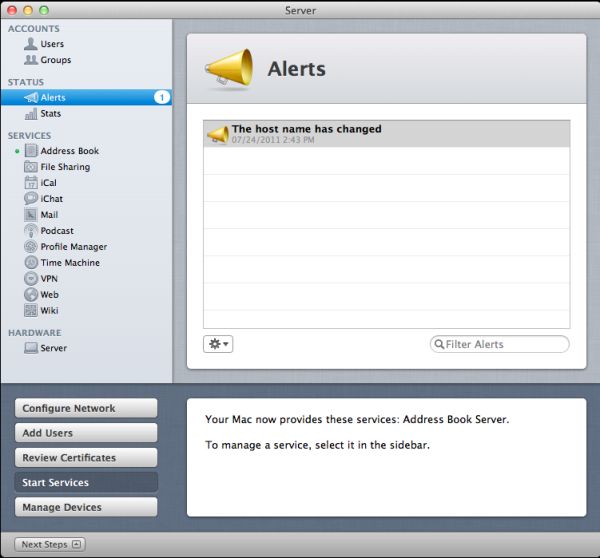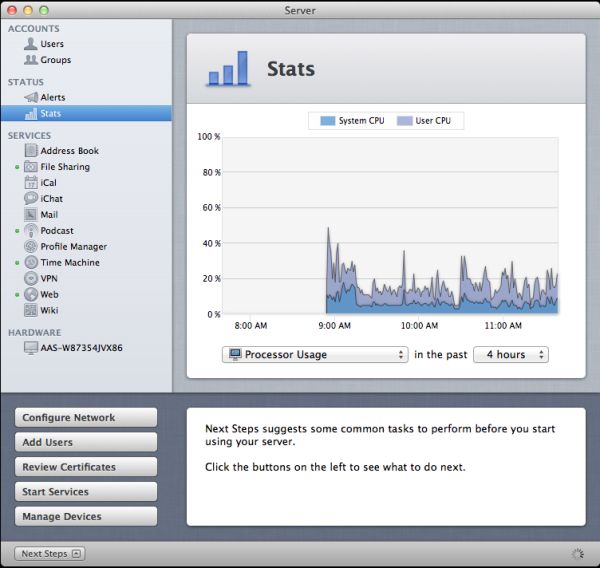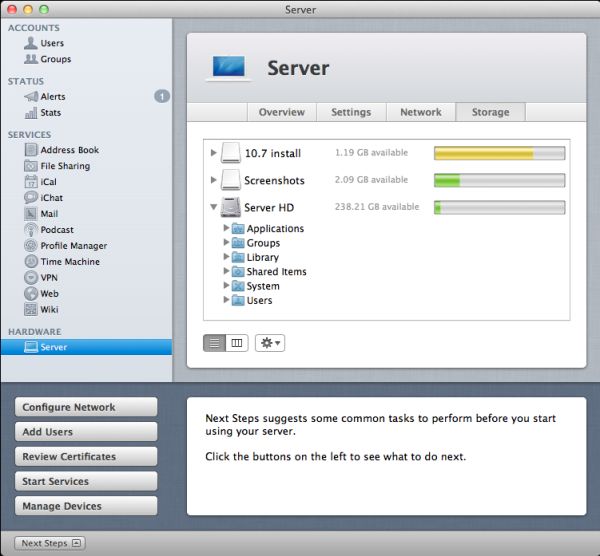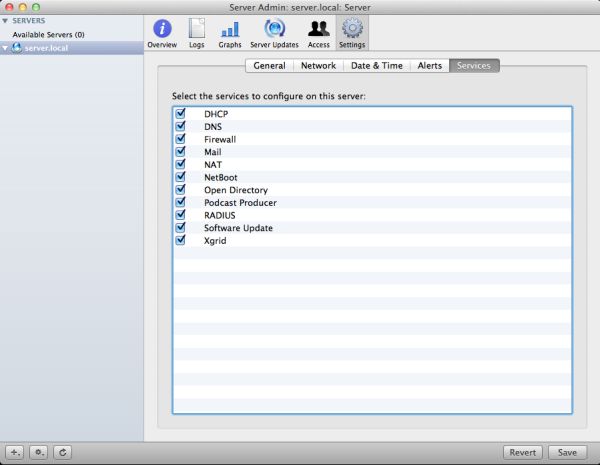In-Depth with Mac OS X Lion Server
by Andrew Cunningham on August 2, 2011 8:00 AM ESTServer.app Overview
Let’s start with Server.app, since it’s going to be the administration tool we’ll use the most throughout this review. I’ll start with a general overview of what it is and what it does, and then I’ll move on to the specific services that it manages.
For small and/or uncomplicated directories, Server.app will be fine for managing your directory, though people wanting to do anything more advanced will want to be familiar with Workgroup Manager (one of the Server Admin Tools that we’ll discuss in depth later).
Moving down the sidebar, our next entries are Alerts and Stats under the Status heading. Alerts is a simple log viewer, showing you messages about your server that you should know (if you have Server.app in your dock, the number of Alerts you have will be displayed with the icon).
Next, under Services, is a full list of every service manageable by Server.app - most of these offer up big on-off switches (I can hear seasoned admins grinding their teeth at this) and some basic configuration options which vary from service to service - we’ll talk more about the available options for each service as we discuss them.
Last up is the Hardware section, which lets you do quite a few things. The Overview tab gives you basic information about your server’s hardware and uptime.
Under the Settings tab, you can enable and disable SSH and remote administration of your server, create and control SSL certificates, and “dedicate system resources to server services,” which enhances the performance of some server functions at the expense of “the performance of some user applications” (this would be a useful box to tick on a dedicated server, but not on a personal computer that’s doing double-duty as a workstation).
Under the Network tab, you can see your server’s various network interfaces and their IP addresses, and you can also change your server’s host name (which is nice, since changing the host name used to require digging around in Server Admin and/or some command line trickery, depending on what you were doing).Lastly, the Storage tab gives you an overview of your available disk space, and also allows you to change the access permissions on files and folders (useful if you have file-sharing enabled, though you should probably do this using the File Sharing service itself, since it is much better at it).
Lastly, at the bottom of the screen, you can see something called Next Steps - this is an excellent place for novices to figure out what to do now that they’ve setup a server. It will guide you through setting up your network, managing network accounts, managing devices, and starting services, among a few other things. Those needing more advanced help can go through the documentation for Lion Server - the page is looking a little sparse right now, especially when compared to the extensive documentation for previous OS X Server versions, but hopefully it will become a little more populated over time.
Lastly, let’s talk about remote administration - if your OS X servers are located in a server room where you don’t have physical access to them, you’ll need a way to manage them remotely. In past OS X Server versions, the Server Admin Tools were installable to any OS X client, and enabled remote administration of most services and tasks.
Server.app, however, is not available for client OS X versions - if you need to administer Lion Server remotely, you’ll either need to change your OS X client into a server (thus giving you access to Server.app, which can be used to connect to other servers), or you must control your servers directly using VNC or Screen Sharing or Apple Remote Desktop (take your pick). It’s not a deal-breaking change, but businesses (whose Lion licensing terms are a bit less generous than those for consumers) will have to cough up for additional Server licenses if they want their admins to administer services on their servers.
We’ll look at the individual Server.app services soon - first, I want to walk you through the Server Admin program and OS X Server’s directory services, since so many of the other services are dependent on them.
Server Admin Overview
As we talked about before, Server Admin used to be the heart of OS X Server. Its role in Lion, while much reduced, is still important, since it still manages some of the software’s more interesting pieces.
Server Admin can still be installed to Lion clients and used to administer Lion Server (and Snow Leopard Server) remotely.
Now, time to talk about some services.

















77 Comments
View All Comments
ex2bot - Friday, August 5, 2011 - link
Upgrading OS X is not much of a pain, as Repo says. Plus, it's practical to skip at least every other upgrade. So, upgrading every four years (2 + 2) at $60 isn't a big deal and the improvements are worth it.I especially appreciate Expose', Time Machine, Spotlight, and Quick Look and use them regularly And every Mac user has benefitted from Quartz GL (uses 3d graphics card to speed up screen draws).. There have been myriad "invisible" or subtle improvements as well. See Apple's "Mac OS X" section for details.
Four years between OS upgrades is not bad, as I said. Longhorn was supposed to come out about 4 or 5 years after XP. Microsoft just had eyes bigger than its stomach and it was delayed. But Windows 7 was worth the wait. Especially features like the display compositor + aesthetically pleasing UI + improved security (and no more yellow speech bubbles popping up all the time)
Ex2bot
Automated System Process
ex2bot - Friday, August 5, 2011 - link
BTW, Expose's successor is called "Mission Control."Sahrin - Tuesday, August 2, 2011 - link
a reduction in advertising, if you guys are going to do all these paid reviews for Apple.Johnmcl7 - Tuesday, August 2, 2011 - link
It's getting a bit of a joke these days that anything with the Apple badge will get a news article, preview, in depth review the moment it's out dwarfing everything else which barely seems to get a look-in. I get that Anand likes Apple stuff and if I don't I should go elsewhere but I like the non-Apple reviews when they do occasionally get published.John
ex2bot - Friday, August 5, 2011 - link
It's no joke. Check Anand's mailbox some time*.Ex2bot
*Crazies, please don't mess with his mailbox.
ex2bot - Friday, August 5, 2011 - link
I know for a fact that Apple employees stuff money into Anand's mailbox*. Lots and lots of money. They use $20s and $50s straight from Jobs' car, who burns them to light his cigs.Ex2bot
Currency Calculating Mac Fanbot
* Anand, I don't really believe this. I was kidding, as I'm sure you've figured out. Actually, I'm sure they are $100s, not $20s and $50s. After all, he's a Billionaire.
the_engineer - Tuesday, August 2, 2011 - link
Thanks for this great in-depth look at Lion Servers new & continued functionality, I learned a lot reading this. However, I'm still very confused at where XSAN fits into the picture. As a storage power-user I've used software Linux raid, semi-hardware windows raid (Intel, Highpoint), and I've lately dabbled into ZFS because it seems like it's really got everything I could ever want as far as straight storage capabilities are concerned (I'm running a raidz6 with 6 750GB drives currently running on Nexenta). I'd really like to put Lion Server on a mac and install a generic SATA card and add 6 3TB hard drives and do a great big raid5 in a mac pro, but am very confused as to whether or not this will work. I was very hopeful that Lion Server would integrate 'software' RAID5 or similar functionality, but it's not clear anywhere whether it does this or not. Simply put, Do I still need to buy a dedicated raid5 card to have a redundant array of inexpensive disks on a mac or am I missing something still?-Looking for a great user experience AND a ton of redundant storage
HMTK - Wednesday, August 3, 2011 - link
Why not set up a NAS with iSCSI or NFS ?the_engineer - Wednesday, August 3, 2011 - link
LONG story short, geting a deidciated NAS box means spending more money than ought to be necessary at this point (I have an i7 desktop and a core2 desktop, both capable of running Lion, Windows, FreeBSD, you name it... Just fine, as well as plenty of vanilla SATA ports & cards available). I'm Trying to weigh all purely software options available to me, with ZFS/BSD sitting on top of the heap for storage features but OSX sitting on top of the heap from a usability standpoint. The longer I look at it the more likely I am to end up running one huge 20-drive ZFS based NAS under FreeBSD but was trying to avoid getting to this point.HMTK - Wednesday, August 3, 2011 - link
If you put it on the network you can access it with all decent OS's. I've got a little HP mini proliant just for that.